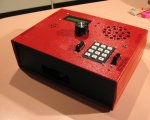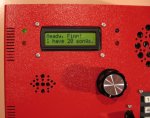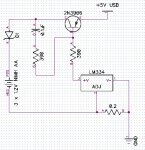This is an MP3 player I built using a VMUSIC module. It has a 128Mb card which is enough for about 24 songs for my 4 year old son. It features a 16x2 LCD to display song titles, run time etc, as well as LEDs to indicate playing, low battery, unit turned on, and charging states. There's a headphone socket so he doesn't disturb the rest of the family, and an in-built 8 ohm speaker, with a simple amp unit to beef up the sound a little. And of course a volume control! It's run off 3 x AA 1.2 NiMH, with a step-up converter to get 5V. You can plug it into a USB port of a PC for charging (a simple charge-n-check circuit), as well as a plug-pack (USB is easiest). It features a keypad and easy to use menu so he can play an individual track, play all, stop, pause etc. He can also check a graphical voltmeter showing the amount of "juice" left in the player, and come see Dad when it's running low 
He typically gets about 7-8 hours of music before it needs a recharge.
He typically gets about 7-8 hours of music before it needs a recharge.
Attachments
-
375.7 KB Views: 148
-
469.6 KB Views: 124



